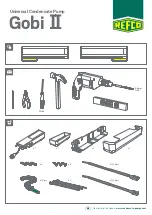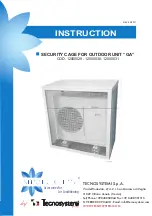
5742640-TIM-A-0419
Johnson Controls Ducted Systems
49
Sequence Of Operation
Cooling Sequence Of Operation
ZD units have Smart Equipment™ Control Board.
With a demand for first stage cooling either from a thermostat or
space sensor, the low-voltage control circuit to "C1" and "G" is
completed. For first stage cooling, the compressor is energized
and the 1st stage operates (67% capacity). The UCB will
energize the VFD equipped blower motor at low speed as set in
the Smart Equipment™ control. When the thermostat calls for
the second stage of cooling, the low-voltage control circuit to
"C2" is completed. The control board energizes the 2nd stage
of the compressor (100% capacity). If there is an initial call for
both stages of cooling, the UCB will delay energizing the 2nd
stage of the compressor by 30 seconds in order to avoid a
power rush. Once the thermostat has been satisfied, it will de-
energize C1 and C2. If the compressor has satisfied the
minimum run time (3 min default), the compressors and
condenser fans are de-energized. Otherwise, the unit operates
until the minimum run has been completed. Upon the
compressor de-energizing, the blower is stopped following the
elapse of the fan off delay for cooling.
The call is passed to the
Unit Control Board (UCB),
which
then determines whether the requested operation is available
and, if so, which components to energize.
If at any time a call for both heating and cooling are present, the
heating operation will be performed. If operating, the cooling
system is halted as with a completion of a call for cooling.
Heating always takes priority.
Continuous Blower
By setting the room thermostat fan switch to "ON," the supply
air blower will operate continuously.
Intermittent Blower
With the room thermostat fan switch set to "AUTO" and the
system switch set to either the "AUTO" or "HEAT" settings, the
blower is energized whenever a cooling or heating operation is
requested. The blower is energized after any specified delay
associated with the operation.
When energized, the indoor blower has a minimum run time of
30 seconds. Additionally, the indoor blower has a minimum off
delay of 10 seconds.
No Outdoor Air Options
When the thermostat calls for cooling, the low-voltage control
circuit from “R” to “Y1” and “G” is completed. The compressor and
condenser fan motor are energized. After completing the specified
fan on delay for cooling, the UCB will energize the blower motor.
Once the thermostat has been satisfied, it will de-energize Y1. If
the compressor has satisfied its minimum run time, the
compressor and condenser fan de-energize. Otherwise, the
unit operates the cooling system until the minimum run time for
the compressor has been completed. After the compressor de-
energizes, the blower is stopped following the elapse of the fan
off delay for cooling.
To be available, a compressor must not be locked-out due to a
high or low-pressure switch or Evaporator Low Limit sensor
(EC1)
detecting a temperature below 26° F Smart Equipment™
Control and the anti-short cycle delay (ASCD) must have
elapsed.
Economizer With Dry Bulb Sensor (Smart Equipment™)
When the room thermostat calls for cooling, the low voltage
control circuit from “R” to “G” and “Y1” is completed. The UCB
energizes the blower motor (if the fan switch on the room
thermostat is set in the “AUTO” position) and drives the
economizer dampers from fully closed to their minimum position.
If the Dry bulb temperature of the outdoor air is below the
setpoint of the enthalpy or dry bulb controller (previously
determined), “Y1” energizes the economizer. The dampers will
modulate to maintain a constant supply air temperature as
monitored by the discharge air sensor. If the outdoor air dry bulb
temperature is above the setpoint, “Y1” energizes the
compressor and condenser fan motor only.
Once the thermostat has been satisfied, it will de-energize “Y1”. If
the compressor has satisfied its minimum run time, the
compressor and condenser fan are de-energized. Otherwise, the
unit operates the cooling system until the minimum run times for
the compressor has been completed. After the compressor de-
energizes, the blower is stopped following the elapse of the fan
off delay for cooling, and the economizer damper goes to the
closed position. If the unit is in continuous fan operation the
economizer damper goes to the min. position.
Economizer With Dual Enthalpy Sensors
The operation with the dual enthalpy sensors is identical to the
single sensor except that a second enthalpy sensor is mounted
in the return air. This return air sensor allows the economizer to
choose between outdoor air and return air, whichever has the
lowest enthalpy value, to provide maximum operating efficiency.
Economizer With Power Exhaust
A unit equipped with an economizer (dry bulb single or dual
enthalpy) and a power exhaust operates as specified above
with one addition. The power exhaust motor is energized 45
seconds after the actuator position exceeds the exhaust fan set
point on the economizer control. When the power exhaust is
operating, the second stage of mechanical cooling will not
operate. As always, the "R" to "G" connection provides
minimum position but does not provide power exhaust
operation.
Motorized Outdoor Air Dampers
This system operation is the same as the units with no outdoor
air options with one exception. When the “R” to “G” circuit is
complete, the motorized damper drives open to a position set
by the thumbwheel on the damper motor. When the “R” to “G”
circuit is opened, the damper spring returns fully closed.
Cooling Operation Errors
Each cooling system is monitored for operation outside of the
intended parameters. Errors are handled as described below. All
system errors override minimum run times for compressors.
















































